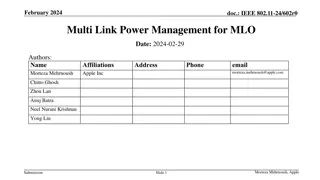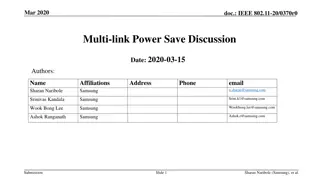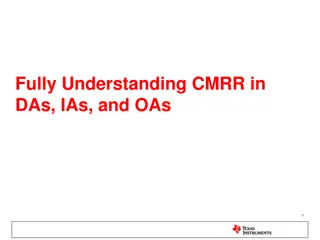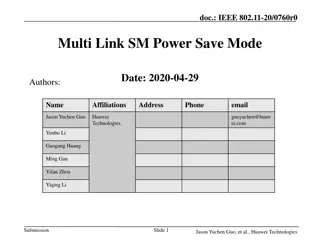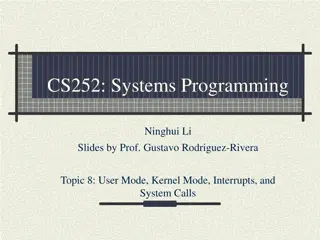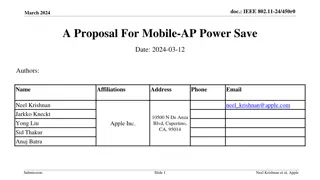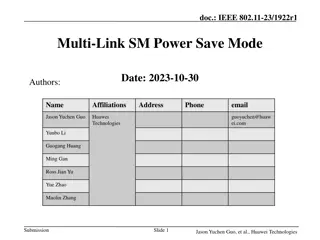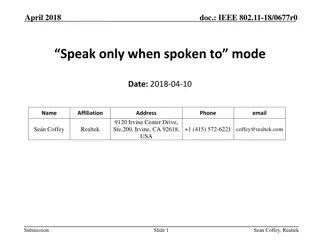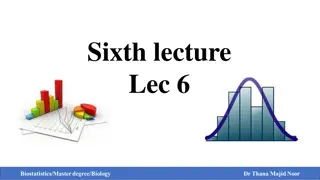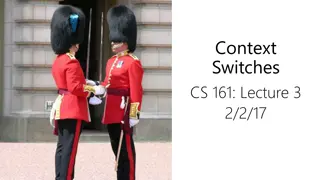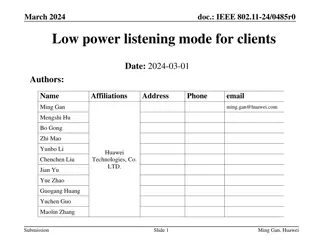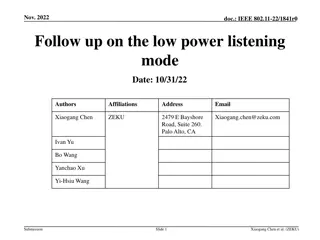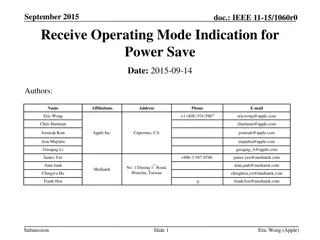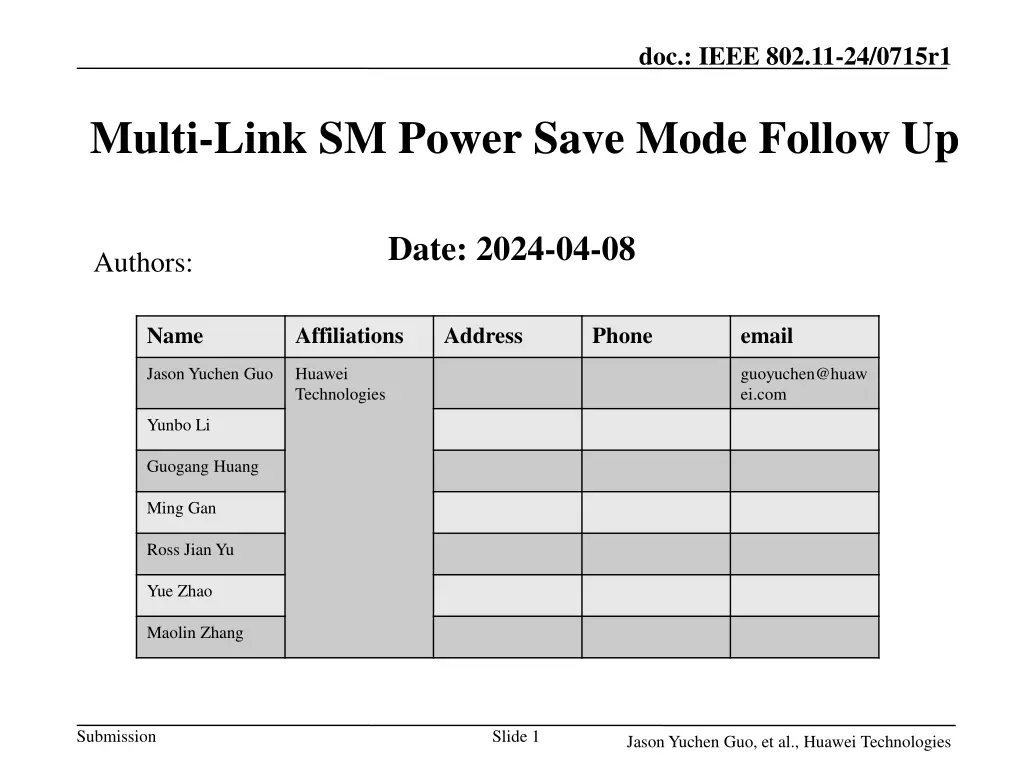
IEEE 802.11-24 Multi-Link SM Power Save Mode Overview
Explore the IEEE 802.11-24/0715r1 document discussing the Multi-Link SM Power Save Mode and its implications for power consumption in MLDs. Learn about the transition between lower and higher capability modes, the use of primary and non-primary links, and the link statuses under the MLSMPS mode. Dive into the details of how non-AP MLDs operate in power save mode and the frame exchange sequences involved.
Download Presentation

Please find below an Image/Link to download the presentation.
The content on the website is provided AS IS for your information and personal use only. It may not be sold, licensed, or shared on other websites without obtaining consent from the author. If you encounter any issues during the download, it is possible that the publisher has removed the file from their server.
You are allowed to download the files provided on this website for personal or commercial use, subject to the condition that they are used lawfully. All files are the property of their respective owners.
The content on the website is provided AS IS for your information and personal use only. It may not be sold, licensed, or shared on other websites without obtaining consent from the author.
E N D
Presentation Transcript
doc.: IEEE 802.11-24/0715r1 Multi-Link SM Power Save Mode Follow Up Date: 2024-04-08 Authors: Name Affiliations Address Phone email Jason Yuchen Guo Huawei Technologies guoyuchen@huaw ei.com Yunbo Li Guogang Huang Ming Gan Ross Jian Yu Yue Zhao Maolin Zhang Submission Slide 1 Jason Yuchen Guo, et al., Huawei Technologies
doc.: IEEE 802.11-24/0715r1 Introduction The following motion has passed for the power save of single-link operation: TGbn defines a power save mode for a STA that is a UHR Mobile AP or a UHR non-AP STA wherein the STA may transition from a lower capability mode to a higher capability mode upon reception of an initial control frame Lower capability mode (e.g., 20 MHz BW, one SS, limited data rates, PPDU format) Higher capability mode (e.g., operating BW, NSS and MCSs, with at least one higher capability than that in the lower power capability mode) Initial Control frame is TBD Whether that applies for a non-mobile AP is TBD Multi-Link operation (MLO) is widely used since Wi-Fi 7, it is strongly required to define power save schemes for MLDs in TGbn. Submission Slide 2 Jason Yuchen Guo, et al., Huawei Technologies
doc.: IEEE 802.11-24/0715r1 Introduction Multi-Link SM power save (MLSMPS) mode has been proposed in TGbe [1-2] and TGbn [3], which aims to reduce the power consumption for MLDs. Under the MLSMPS mode, a non-AP MLD uses a single link for listening, and becomes available on multiple links when it receives an initial control frame (ICF). After the frame exchange sequence, the non-AP MLD is available on only one link. The link that is used for listening and receiving ICF is named as MLSM primary link The link(s) that become available after receiving ICF are named as MLSM non-primary link(s) Both the MLSM primary link and the MLSM non-primary links are named as MLSM links The ICF shall be transmitted using non-HT (dup) PPDU, with one spatial stream, and low MCS (e.g., MCS 0~3), which can be received using low capability. The ICF shall also indicate the links that the AP MLD intends to use to transmit to the non-AP MLD. Submission Slide 3 Jason Yuchen Guo, et al., Huawei Technologies
doc.: IEEE 802.11-24/0715r1 Link status under MLSMPS mode MLSM Primary link: Initial status: listen for ICF using low capability After receiving ICF: transition to high capability to receive data frame After frame exchange: transition to low capability to listen for ICF MLSM Non-Primary link: Initial status: unavailable After receiving ICF on the MLSM primary link: become available, able to receive data frame using high capability After frame exchange: become unavailable If no frame exchange: become unavailable after a timeout period Low capability High capability Low capability MLSM Primary link ICF Data Exchanges ICR Data Exchanges MLSM non- Primary links Data Exchanges off off High capability Submission Slide 4 Jason Yuchen Guo, et al., Huawei Technologies
doc.: IEEE 802.11-24/0715r1 How to determine MLSM Links Step 1: during setup procedure, the non-AP MLD will indicate a set of setup links as the candidate set of links (Set 1) for the AP MLD to choose to transmit to the non-AP MLD under the MLSMPS mode Step 2: in the ICF transmitted by the AP MLD on the MLSM primary link, the AP MLD can indicate the links (Set 2) that the AP MLD intends to use to transmit data frames to the non-AP MLD Set 2 is a subset of Set 1 Note: AP MLD can determine Set 2 based on the scheduling (which links to use to transmit data to the non-AP MLD) Step 3: in the ICR transmitted by the non-AP MLD on the MLSM primary link (as the response to the ICF), the non-AP MLD can further indicate the links (Set 3) that the non-AP MLD is ready to receive the data from the AP MLD Set 3 is a subset of Set 2 Note: the non-AP MLD may not be able to receive on all the indicated MLSM links during the setup procedure due to in-device coexistence issue, hence the non-AP MLD can choose a subset of links to receive Submission Slide 5 Jason Yuchen Guo, et al., Huawei Technologies
doc.: IEEE 802.11-24/0715r1 ICF & ICR details There are many schemes that require ICF/ICR exchange, e.g., dynamic power save, IDC protocol, DSO, etc We can use similar design for the ICF/ICR as proposed in those schemes, e.g., Reuse MU-RTS/BSRP (with some modifications) Use a new type of trigger frame Define new A-Control fields Reuse Multi-STA BA Define new control frames The information needed to be carried in the ICF/ICR is: The link(s) that the AP MLD intends to use The link(s) that the non-AP MLD is ready to use Submission Slide 6 Jason Yuchen Guo, et al., Huawei Technologies
doc.: IEEE 802.11-24/0715r1 Conclusion We propose a MLSMPS mode for the non-AP MLD to save power under the MLO framework The non-AP MLD uses one link for listening, and becomes available on multiple links after receiving ICF. The AP MLD can indicate the links that it intends to use to transmit data frames to the non-AP MLD in the ICF The non-AP MLD can indicate the links that the non-AP MLD is ready to receive the data from the AP MLD in the ICR Submission Slide 7 Jason Yuchen Guo, et al., Huawei Technologies
doc.: IEEE 802.11-24/0715r1 Straw Poll Do you agree to define a MLSMPS mode in TGbn as follows: A non-AP MLD that is in MLSM PS mode can use only one link and one active receive chain for receiving and responding to an initial frame sent by the AP, and addressed to it The non-AP MLD becomes available on other links after responding to the initial frame The non-AP MLD may become unavailable on any of the other links if The TXOP on the other link has ended, or the non-AP MLD does not receive any frame addressed to it on the other links within a timeout period Submission Slide 8 Jason Yuchen Guo, et al., Huawei Technologies
doc.: IEEE 802.11-24/0715r1 References [1] 11-20-0760-05-00be-multi-link-sm-power-save-mode [2] 11-22-1250-05-00be-lb266-cr-for-ml-sm-power-save-mode [3] 11-23-1922-00-00bn-Multi-Link-SM-Power-Save-Mode Submission Slide 9 Jason Yuchen Guo, et al., Huawei Technologies


